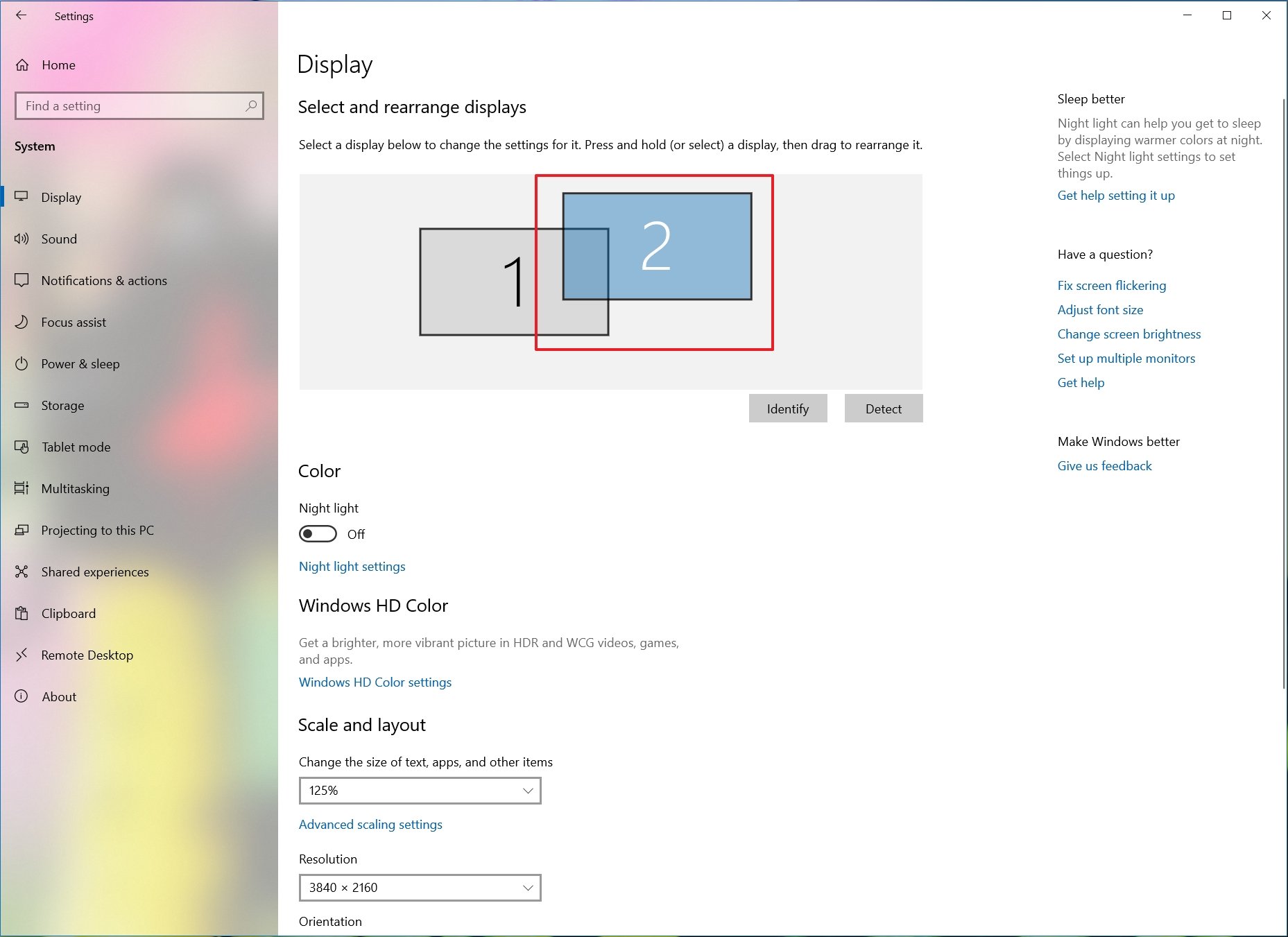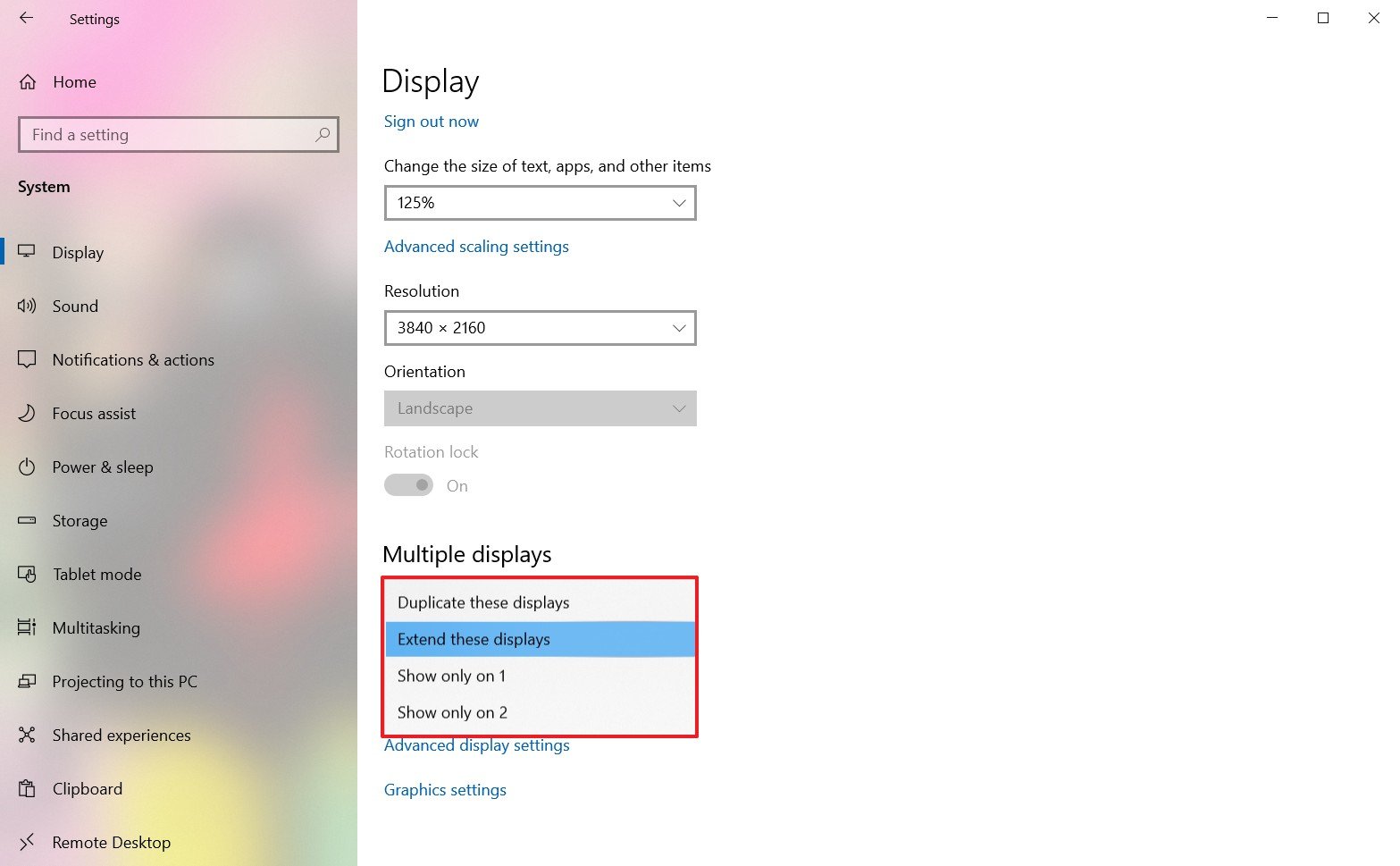How To Change Resolution On Second Monitor
Whether you're content creator, programmer, data annotator, gamer, or someone who'southward recently been forced to piece of work from domicile, a organization with multiple monitors not only looks great, but it can significantly improve productivity when multitasking with several apps. However, a multi-monitor setup is only practical as long as you configure it correctly.
Windows 10 has several features and settings to support one, two, iii, four, and fifty-fifty more monitors without the need for third-party software for the best experience.
In this Windows x guide, we'll walk yous through a bunch of tips to configure and apply a multi-monitor setup, whether y'all're connecting an external display to your laptop, or you're connecting two, three, or more than monitors to your workstation.
- Before configuring a multi-monitor setup
- How to rearrange multiple displays on Windows ten
- How to adjust displays calibration and layout on Windows 10
- How to select multiple displays viewing mode on Windows 10
- How to manage advanced display settings on Windows ten
- How to show taskbar across multiple displays on Windows ten
- How to modify background on multiple displays on Windows 10
Before configuring a multi-monitor setup
Before configuring multiple monitors on your device, brand certain that all the necessary cables are connected to the monitors and the computer. This includes connecting power and video signal using VGA, DVI, HDMI, or DisplayPort (recommended) cables.
If you're not sure, confirm the make and model of the monitor (usually from a sticker in the back), and search online for the manufacturer manual to go a better idea on how to connect the display.
How to rearrange multiple displays on Windows 10
While you tin connect a monitor to whatever available video ports on the graphics card, when setting up a dual-monitor or triple-monitor setup, it'southward piece of cake to plug them in the incorrect order. Although they will still work, y'all may come across bug using the mouse and running applications until yous rearrange them correctly.
To rearrange monitors on Windows ten, employ these steps:
- Open up Settings.
- Click on System.
- Click on Display.
-
Under the "Select and rearrange displays" section, drag and driblet each display to rearrange them according to their physical layout on your desktop.
 Source: Windows Central
Source: Windows Central Quick tip: When rearranging monitors in the "Display" settings page, brand certain that all monitors align at the top perfectly. Otherwise, yous'll take problems moving the mouse cursor between monitors from the corners.
- Click the Apply button.
In one case you complete the steps, Windows ten will save the physical layout, and you lot'll be able to work across each brandish and run apps without issues.
If you're non certain which monitor you're selecting, click the Identify push to figure out. If i of the monitors isn't showing up, make sure it'southward receiving power and connected correctly, and click the Find push button. In the instance that you're still having problems, reset their connections (or restart the computer), and try the Discover button again.
How to adjust displays scale and layout on Windows x
When connecting one or multiple displays to a computer, Windows 10 does a pretty good job detecting and configuring the nearly optimal settings. However, depending on your requirements, yous may need to arrange scaling, resolution, and orientation for each monitor.
Selecting correct scale
Windows x includes settings to suit the scaling, which are useful when setting up various monitors of different sizes and screen resolutions to make text, apps, and other items await the same size across the displays. Or, if you have a 4K display, for example, adjusting the scale settings can aid to make items bigger and more readable.
To select the correct scale setting that suits your requirements, utilise these steps:
- Open up Settings.
- Click on Organization.
- Click on Display.
- Under the "Select and rearrange displays" section, select the monitor that you desire to suit.
-
Use the Modify the size of text, apps, and other items drib-downwards menu to select the appropriate scale choice.
 Source: Windows Central
Source: Windows Central
After you complete the steps, yous may need to repeat steps No. iv and 5 to change the scaling settings on the other monitors, then click the Sign-out pick to use the changes.
While yous can arrange the scaling settings on a per-monitor basis, when possible, it's always all-time to utilise the same brand and model of the monitors with the same configuration. Otherwise, you may run into issues, and Windows 10 may have issues scaling elements.
If y'all're in the market for a second monitor to expand your laptop or desktop sheet, we recommend the Dell UltraSharp U2719D because of its authentic color reproduction, size, slim vessel pattern, VESA mount compatibility, and value.
Custom scaling
To specify a custom scaling value, employ these steps:
- Open Settings.
- Click on System.
- Click on Brandish.
- Under the "Select and rearrange displays" department, select the monitor that you desire to adjust.
-
Nether the "Calibration and layout" section, click the Advanced scaling settings pick.
 Source: Windows Central
Source: Windows Central -
Under the "Custom scaling" section, specify the scaling size betwixt 100 and 500 per centum.
 Source: Windows Central
Source: Windows Central - Click the Apply button.
Later on you complete the steps, sign out of your business relationship and sign back in to test the new settings. If the new scaling configuration doesn't look right, apply the aforementioned steps once more and effort a different value until you find a comfy setting.
If you want to switch to the predefined scale settings, you lot must outset turn off custom scaling and sign out. Otherwise, the pick will exist grayed out.
Selecting correct resolution
Normally, after connecting a monitor, Windows 10 will set the recommended pixel resolution automatically, but yous can also change the resolution manually with these steps:
- Open Settings.
- Click on Organization.
- Click on Brandish.
- Under the "Select and rearrange displays" section, select the monitor that you want to adjust.
-
Under the "Calibration and layout" section, use the Resolution drop-down menu to select the correct pixel resolution.
 Source: Windows Central
Source: Windows Central
Once you lot complete the steps, repeat steps No. 4 and five to modify the resolution on the remaining monitors.
If you're looking to make text and other items bigger on the screen, you should be changing the scaling settings, not the display resolution.
Selecting correct orientation
Windows ten likewise allows you to rotate the screen horizontally or vertically, which is particularly useful when you have monitors with stands that rotate, and you desire to use them with a unlike orientation for reading or coding.
To change the orientation per-monitor, utilise these steps:
- Open Settings.
- Click on Organisation.
- Click on Brandish.
- Under the "Select and rearrange displays" section, select the monitor that you desire to adjust.
-
Nether the "Scale and layout" department, employ the Orientation drop-down menu to select the mode:
- Landscape.
- Portrait.
- Landscape (flipped).
- Portrait (flipped).
 Source: Windows Cardinal
Source: Windows Cardinal
One time you consummate the steps, the display will shift to the orientation you selected.
How to select multiple displays viewing style on Windows 10
Using the available settings, you tin can also choose the viewing mode for your displays. For example, if you're using a second monitor, you tin can expand the chief screen to the new display, or you can mirror both monitors, which is an ideal option when showing a presentation. If you're using a laptop with an external monitor, you tin fifty-fifty disable the main display, and only use the second monitor equally your primary.
To change the viewing mode on Windows 10, use these steps:
- Open Settings.
- Click on System.
- Click on Display.
- Nether the "Select and rearrange displays" section, select the monitor that you desire to adjust.
-
Under the "Multiple displays" department, use the drop-down menu to gear up the advisable viewing fashion:
- Duplicate desktop — Shows the same desktop on both displays.
- Extend — Expands the primary desktop to the secondary display.
- Disconnect this display — Plough off the selected monitor.
 Source: Windows Central
Source: Windows Central
Afterwards you lot complete the steps, you lot may demand to repeat steps No. 4 and 5 to set the display mode on the remaining monitors. Also, note that using these settings, you lot can brand any of the monitors as your primary brandish.
Switching display modes with shortcut
In improver to using the Settings app, Windows 10 also allows yous to switch display modes on the fly using the Projection characteristic, which y'all can access using the Windows cardinal + P keyboard shortcut.
 Source: Windows Key
Source: Windows Key
Once yous invoke the shortcut, a flyout will open from the right side with iv options, including:
- PC screen only — Only the chief display is used.
- Indistinguishable — Secondary displays will mirror the main monitor.
- Extend — Both screens are combined to offering an extended desktop.
- Second screen merely — Only the secondary displays is used.
Typically, when using a multi-monitor setup on a desktop or laptop, you lot desire to use the "Extend" option. This allows you to use the main monitor usually and the secondary monitors at their native resolution creating a single big sheet.
Duplicate is a good selection when using a 2nd monitor or projector to show a presentation. In dissimilarity, the Second screen only option is neat when y'all desire to close the lid on a laptop and work only with the external monitor.
How to manage advanced display settings on Windows 10
Although it's non always recommended to alter your advanced display settings, because non all monitors are created equal, sometimes, y'all may demand to make a few adjustments to ameliorate color accuracy and remove screen flickering.
Important: We just recommend adjusting the avant-garde settings if you accept a crude idea of what to do. Typically, yous should be fine with the default display settings.
Setting a custom color profile
If your monitors aren't rendering the colors accurately, you tin can utilise a custom color profile to amend color accuracy using these steps:
- Open up Settings.
- Click on Organisation.
- Click on Display.
-
Click the Advanced display settings choice.
 Source: Windows Primal
Source: Windows Primal -
Click the Display adapter properties option for the display that yous want to set a custom color profile.
 Source: Windows Cardinal
Source: Windows Cardinal - Click the Colour Direction tab.
-
Click the Colour Management button.
 Source: Windows Central
Source: Windows Central - Click the Devices tab.
- Select a brandish from the list.
- Check the Apply my settings for this brandish selection.
-
Click the Add button.
 Source: Windows Cardinal
Source: Windows Cardinal -
On the "Associate Color Profile" folio, click the Browse button and locate the new color profile.
 Source: Windows Central
Source: Windows Central - Double-click the .icm file to install the new profile.
-
Click the Close button.
 Source: Windows Key
Source: Windows Key
One time you consummate the steps, you may need to repeat steps No. 9 through xiii to set a custom profile for the other monitors.
When configuring a custom color contour, yous should use those created by your display manufacturer or from a trusted source. If you lot're not sure, you lot can use these steps to download the correct colour profile for your monitors.
Changing the refresh rate
Usually, a refresh rate (frames per second) of 59Hz or 60Hz is more than enough to operate a figurer, though you'll definitely want to expect at the best monitors for Xbox Serial 10 and Series S if yous plan to game at higher framerates. However, if you're noticing screen flickering, or if you lot have monitors that support a college refresh rate, bumping the settings tin can provide a ameliorate and smoother viewing experience — peculiarly for gamers.
To suit the refresh rate of a monitor, employ these steps:
- Open Settings.
- Click on Arrangement.
- Click on Display.
-
Click the Advanced brandish settings option.
 Source: Windows Central
Source: Windows Central -
Click the Brandish adapter backdrop option for the display you want to modify the refresh rate.
 Source: Windows Central
Source: Windows Central - Click the Monitor tab.
-
Under the "Monitor Settings" section, apply the drop-downward menu to set up the correct refresh rate.
 Source: Windows Primal
Source: Windows Primal
After you complete the steps, y'all may need to repeat steps No. 5, 6, and seven to change the refresh rate on the remaining monitors.
How to show taskbar across multiple displays on Windows 10
On a multi-monitor setup, the taskbar by default volition appear merely in the main display, but you can change the settings to show it beyond all the displays using these steps:
- Open Settings.
- Click on Personalization
- Click on Taskbar.
-
Under the "Multiple brandish" section, plow on the Show taskbar on all displays toggle switch.
 Source: Windows Central
Source: Windows Central
If you want to control in which taskbar the buttons for running apps should announced, then use the Evidence taskbar push button on the drop-down menu and select i of the available options:
- All taskbars.
- Main taskbar and taskbar where window is open.
- Taskbar where window is open up.
Also, you lot tin can utilise this guide to optimize the space on the taskbar to pin even more apps or to keep it as minimal as possible.
How to alter background on multiple displays on Windows 10
Windows 10 offers a lot of settings to adjust the expect and experience of the desktop, but when using multiple monitors, setting up different groundwork images on each display is i the most significant customization that you can make to personalize your experience.
To show different wallpapers on a multi-monitor setup using a slideshow, use these steps:
- Open Settings.
- Click on Personalization.
- Click on Background.
-
Employ the "Groundwork" drop-downward menu and select the Slideshow pick.
 Source: Windows Central
Source: Windows Central - Click the Browse button.
- Select a folder with a collection of images that you lot'd similar to brandish on the monitors.
- Click the Choose this folder button.
- Use the "Change picture show every" drop-down menu to select the rotation frequency.
- Plow on the Shuffle toggle switch.
- (Optional) If you're using unlike sized images, use the Cull a fit drop-down menu and select the Fill option.
Once you consummate the steps, the images will rotate on the desktop background using the rotation frequency that y'all selected.
Customizing each monitor with a unlike background
If you want to set a different groundwork image for each monitor, use these steps:
- Open Settings.
- Click on Personalization.
- Click on Background.
-
Use the "Background" drop-downward menu and select the Picture choice.
 Source: Windows Key
Source: Windows Key - Click the Browse push button.
- Select the wallpaper and click the Choose picture option.
-
Right-click the paradigm and select the monitor you want the wallpaper to testify.
 Source: Windows Central
Source: Windows Central - Repeat steps No. five, 6, and 7 to set a custom background for another monitor.
After you complete the steps, each monitor volition display a custom wallpaper.
In add-on to the instructions outlined higher up, here are a few additional tips to keep in mind when setting upward a computer with multiple monitors. For example, unless it'due south a laptop, you shouldn't endeavour to suit the effulgence or colour using Windows 10 or some other application. Instead, you should use the controls built into the monitor.
In the instance that the second monitor isn't getting detected, check its connections, and use the Find button in the Settings app. If you're all the same having issues, you can employ this guide to troubleshoot and fix mutual problems.
Finally, when using i or multiple monitors, you may come beyond a blackness screen, which it'south typically a video driver related trouble. If you're not sure how to fix this issue, you lot can follow these steps to resolve the problem.
More than Windows 10 resource
For more helpful articles, coverage, and answers to common questions about Windows 10, visit the following resources:
- Windows 10 on Windows Key – All you need to know
- Windows 10 help, tips, and tricks
- Windows 10 forums on Windows Central
We may earn a commission for purchases using our links. Learn more.

Future plans for FFXIV
Post-launch roadmap for Last Fantasy 14: Endwalker revealed
The latest Alphabetic character from the Producer livestream has just aired, and information technology comes with a plethora of news for Final Fantasy Xiv. This includes plans for updating all the master scenario quest dungeons, improving the graphics, implementing new sidequests, and much more.

Buyer'southward guide
These are the best Netgear routers available now
Dear Netgear and desire to improve your home internet? We've rounded up the best routers available now, whether you're looking to game, ready a mesh network, or just enjoy lag-costless cyberspace in your home.
Source: https://www.windowscentral.com/how-connect-and-set-multiple-monitors-windows-10
Posted by: sanchezalmle1941.blogspot.com




















0 Response to "How To Change Resolution On Second Monitor"
Post a Comment